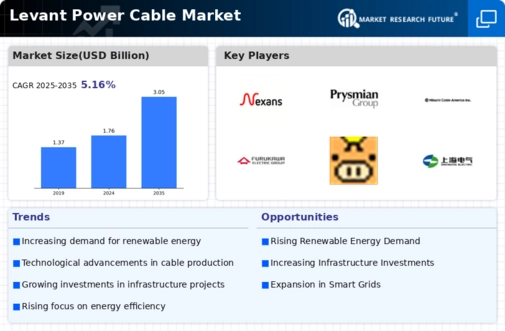Market Growth Projections
The Global Levant Power Cable Market Industry is poised for substantial growth in the coming years. Projections indicate that the market will expand from 1.76 USD Billion in 2024 to an estimated 3.05 USD Billion by 2035. This growth trajectory suggests a robust demand for power cables driven by various factors, including infrastructure development, renewable energy initiatives, and technological advancements. The anticipated CAGR of 5.12% from 2025 to 2035 further underscores the market's potential, highlighting the increasing investments in energy infrastructure and the critical role of power cables in supporting global energy needs.
Growing Demand for Renewable Energy
The Global Levant Power Cable Market Industry is experiencing a surge in demand driven by the increasing focus on renewable energy sources. Governments and organizations are investing heavily in wind, solar, and hydroelectric projects, necessitating robust power cable solutions to transmit electricity efficiently. For instance, countries in the Levant region are expanding their renewable energy capacities, which is projected to contribute significantly to the market's growth. The industry's value is expected to reach 1.76 USD Billion in 2024, reflecting a shift towards sustainable energy solutions and the need for advanced infrastructure to support these initiatives.
Infrastructure Development Initiatives
Infrastructure development remains a pivotal driver for the Global Levant Power Cable Market Industry. Various nations are undertaking extensive projects to modernize their electrical grids and expand power distribution networks. This is particularly evident in urban areas where population growth demands enhanced energy supply systems. For example, the construction of new residential and commercial buildings necessitates the installation of high-quality power cables. As a result, the market is anticipated to grow at a CAGR of 5.12% from 2025 to 2035, indicating a sustained investment in infrastructure that supports the evolving energy landscape.
Regulatory Support for Energy Efficiency
Regulatory frameworks promoting energy efficiency are shaping the Global Levant Power Cable Market Industry. Governments are implementing policies that encourage the adoption of energy-efficient technologies and practices, which often include the use of advanced power cables. These regulations aim to reduce energy consumption and greenhouse gas emissions, aligning with global sustainability goals. As a result, manufacturers are increasingly focusing on producing cables that meet stringent energy efficiency standards. This regulatory support not only fosters innovation but also drives market growth, as stakeholders seek to comply with evolving energy policies.
Increasing Urbanization and Electrification
Urbanization trends are propelling the Global Levant Power Cable Market Industry forward. As populations migrate to urban centers, the demand for reliable electricity supply escalates, necessitating the expansion of power distribution networks. This urban growth often leads to increased electrification efforts, particularly in developing regions where access to electricity remains limited. Governments are prioritizing investments in electrical infrastructure to support urban development, which in turn drives the demand for power cables. The market is expected to witness substantial growth, with projections indicating a rise to 3.05 USD Billion by 2035, reflecting the critical need for enhanced energy solutions.
Technological Advancements in Cable Manufacturing
Technological innovations in cable manufacturing are significantly influencing the Global Levant Power Cable Market Industry. The introduction of advanced materials and production techniques enhances the performance and durability of power cables, making them more suitable for various applications. For instance, the development of high-temperature superconductors and improved insulation materials allows for greater efficiency in power transmission. These advancements not only reduce energy losses but also lower maintenance costs, thereby attracting investments in power cable solutions. As the industry evolves, these technological improvements are likely to play a crucial role in meeting the growing energy demands.










